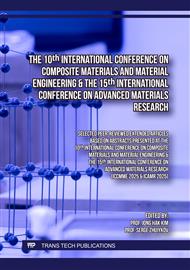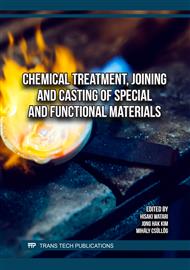p.33
p.45
p.57
p.77
p.83
p.89
p.95
p.105
p.117
Biochar-Containing Microcapsule/Recycled Polyethylene Composite with Temperature Regulation Capabilities
Abstract:
A phase change material (PCM) was encapsulated within a novel polymer shell to prevent leakage during the phase transition. Additionally, biochar was incorporated into the shell to enhance its thermal conductivity. Initially, methyl methacrylate (MMA) and triethoxyvinylsilane (TEVS) were copolymerized to form a prepolymer. Following this, biochar was added to create phase change microcapsules with biochar in the shell and octadecane in the core (BC-PCM), resulting in high thermal conductivity. The average size of the BC-PCM was approximately 30 nm. The BC-PCM was then added to recycled polyethylene (rPE) to produce a thermally conductive phase change composite. The results indicated that the tensile strength of the BC-PCM-containing composite was slightly higher than that of pure rPE. However, the impact strength of the BC-PCM-containing composite was lower than that of pure rPE. Moreover, the thermal conductivity of rPE increased after the addition of BC-PCM. The light exposure test showed that the temperature of BC-PCM-containing composite is lower than rPE by 1.4°C (from 26.2°C to 24.8°C) after 15 minutes of light exposure, confirming its thermal buffering properties and temperature regulation capabilities.
Info:
Periodical:
Pages:
83-88
Citation:
Online since:
June 2025
Authors:
Keywords:
Price:
Сopyright:
© 2025 Trans Tech Publications Ltd. All Rights Reserved
Share:
Citation:



